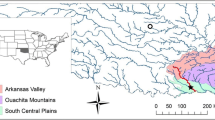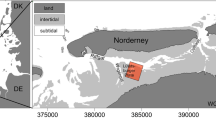Abstract
Sidescan sonar holds great promise as a tool to quantitatively depict the distribution and extent of benthic habitats in Louisiana’s turbid estuaries. In this study, we describe an effective protocol for acoustic sampling in this environment. We also compared three methods of classification in detail: mean-based thresholding, supervised, and unsupervised techniques to classify sidescan imagery into categories of mud and shell. Classification results were compared to ground truth results using quadrat and dredge sampling. Supervised classification gave the best overall result (kappa=75%) when compared to quadrat results. Classification accuracy was less robust when compared to all dredge samples (kappa=21–56%), but increased greatly (90–100%) when only dredge samples taken from acoustically homogeneous areas were considered. Sidescan sonar when combined with ground truth sampling at an appropriate scale can be effectively used to establish an accurate substrate base map for both research applications and shellfish management. The sidescan imagery presented here also provides, for the first time, a detailed presentation of oyster habitat patchiness and scale in a productive oyster growing area.
Similar content being viewed by others
Literature Cited
Able, K. W., D. C. Twichell, C. B. Grimes, andR. S. Jones. 1987. Sidescan sonar as a tool for detection of demersal fish habitats.Fishery Bulletin 85:725–736.
Anderson, J. R., E. E. Hardy, J. T. Roach, and R. E. Witmer. 1976. A land use and land cover classification system for use with remote sensor data. U.S. Geological Survey Professional Paper, No. P 0964. Reston, Virginia.
Berrigan, M. 1988. Management of oyster resources in Apalachicola Bay following Hurricane Elena.Journal of Shellfish Research 7:281–288.
Brodtmann, N. V. 1991. Engineering and biological studies of reconstructed oyster habitat.Journal of Shellfish Research 10:399–403.
Call, K. A., J. T. Hardy, andD. O. Wallin. 2003. Coral reef habitat discrimination using multivariate spectral analysis and satellite remote sensing.International Journal of Remote Sensing 24:2627–2639.
Congalton, R. G. 1991. A review of assessing the accuracy of classification of remotely sensed data.Remote Sensing of Environment 37:35–46.
Foody, G. M. 2002. Status of land cover classification accuracy assessment.Remote Sensing of Environment 80:185–201.
Gardner, J. V., L. A. Mayer, J. E. Hughes Clarke, andA. Kleiner. 1998. High-resolution multibeam bathymetry of east and west Flower Gardens and Stetson Banks, Gulf of Mexico.Gulf of Mexico Science XVI 16:131–144.
Haltuch, M. A. andP. A. Berkman. 2000. Geographic information system (GIS) analysis of ecosystem invasion: Exotic mussels in Lake Erie.Limnology and Oceanography 45:1778–1787.
Harding, J. M. andR. Mann. 2003. Influence of habitat on diet and distribution of striped bass (Morone saxatilis) in a temperate estuary.Bulletin of Marine Science 72:841–851.
Huvenne, V. A. I., P. Blondel, andJ.-P. Henriet. 2002. Textural analyses of sidescan sonar imagery from two mound provinces in the Porcupine Seabight.Marine Geology 189:323–341.
Kennedy, V. S. 1996. Biology of larvae and spat, p. 371–421.In V. S. Kennedy, R. I. E. Newell, and A. F. Eble (eds.), The Eastern Oyster,Crassostrea virginica. Maryland Sea Grant College, College Park, Maryland.
Kenny, A. J., I. Cato, M. Desprez, G. Fader, R. T. E. Schüttenhelm, andJ. Side. 2003. An overview of seabed-mapping technologies in the context of marine habitat classification.ICES Journal of Marine Science 60:411–418.
Lehnert, R. L. andD. M. Allen. 2002. Nekton use of subtidal oyster shell habitat in a southeastern U.S. estuary.Estuaries 25:1015–1024.
Mather, P. M. 1999. Computer Processing of Remotely Sensed Images. Wiley and Sons, New York.
Melancon, E., T. Soniat, V. Cheramie, R. Duga, J. Barras, andM. Lagarde. 1998. Oyster resource zones of the Barataria and Terrebone estuaries of Louisiana.Journal of Shellfish Research 17:1143–1148.
Ojeda, G. Y., P. T. Gayes, R. F. Van Dolah, andW. C. Schwab. 2004. Spatially quatitative seafloor habitat mapping: An example from the northern South Carolina inner continental shelf.Estuarine, Coastal and Shelf Science 59:399–416.
Peterson, C. H., J. H. Grabowski, andS. P. Powers. 2003. Estimated enhancement of fish production resulting from restoring oyster reef habitat: Quantitative valuation.Marine Ecology-Progress Series 264:249–264.
Roberts, H. R., C. A. Wilson, J. Supan, andW. Winans. 1999. New technology for characterizing Louisiana’s shallow coastal bottom and predicting future changes.Gulf Coast Association of Geological Societies Transactions XLIX:452–460.
Smith, G. F. andK. N. Greenhawk. 1998. Shellfish benthic habitat assessment in the Chesapeake Bay: Progress toward integrated technologies for mapping and analysis.Journal of Shellfish Research 17:1433–1437.
Smith, G. F., K. N. Greenhawk, D. G. Bruce, E. B. Roach, andS. J. Jordan. 2001. A digital presentation of the Maryland oyster habitat and associated bottom types in the Chesapeake Bay (1974–1983).Journal of Shellfish Research 20:197–206.
Soniat, T. M. andM. S. Brody. 1988. Field validation of a habitat suitability index model for the American oyster.Estuaries 11:87–95.
Tou, J. T. andR. C. Gonzales. 1974. Pattern Recognition Principles. Addison-Wesley Publishing Company, Reading, Massachusetts.
Tso, B. andP. M. Mather. 2001. Classification Methods for Remotely Sensed Data. Taylor and Francis, New York.
Turner, R. E., E. M. Swenson, M. Kasprzak, and T. Remaire. 1998. Water chemistry.In C. E. Sasser and J. M. Visser (eds.), LOOP marine and estuarine monitoring program, 1978–95, Coastal Ecology Institute, Louisiana State University, Volume 2. Prepared for Louisiana Transportation Research Center Research Report Number 316, LTRC Project No. 97-3IMP, State Project No. 736-99-0449. Baton Rouge, Louisiana.
White, W. H., A. R. Harborne, I. S. Sotheran, R. Walton, andR. L. Foster-Smith. 2003. Using an acoustic ground discrimination system to map coral reef benthic classes.International Journal of Remote Sensing 24:2641–2660.
Wildish, D. J., G. B. J. Fader, P. Lawton, andA. J. MacDonald. 1998. The acoustic detection and characteristics of sublittoral bivalve reefs in the bay of Fundy.Continental Shelf Research 18:105–113.
Sources of Unpublished Materials
National Marine Fisheries Service (NMFS). 2004. Annual Commercial Landing Statistics. http://www.st.nmfs.gov/stl/ commercial/landings/annual_landings.html
Pausina, R. Personal Communication. 6551 Louisville Street, New Orleans, LA 70124.
Roberts, H. Personal Communication. Coastal Studies Institute, Louisiana State University, Baton Rouge, Louisiana 70803.
Author information
Authors and Affiliations
Corresponding author
Rights and permissions
About this article
Cite this article
Allen, Y.C., Wilson, C.A., Roberts, H.H. et al. High resolution mapping and classification of oyster habitats in nearshore Louisiana using sidescan sonar. Estuaries 28, 435–446 (2005). https://doi.org/10.1007/BF02693925
Received:
Accepted:
Issue Date:
DOI: https://doi.org/10.1007/BF02693925




